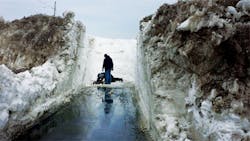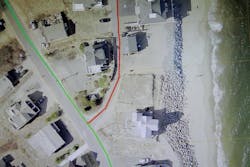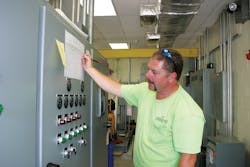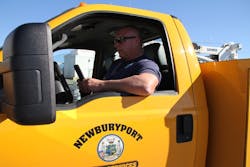Birth of a Smart Sewer
About the author:
Jamie Tuccolo is collection system superintendent for Newburyport, Mass. Tuccolo can be reached at [email protected]
Nor’easters in Massachusetts are routine. They happen most winters and often dump heavy snow throughout the region. No big deal. No one, however, was prepared for the winter of 2015.
An unprecedented series of weather events in January and February dropped about 110 in. of snow along the Massachusetts coastline in a four-week time frame. By comparison, the average annual snowfall is about 43 in. Snow buried everything. Travel and commerce stopped; there were not enough snowplows to adequately clear the roads. Meanwhile, temperatures plummeted to near-record lows. The governor declared a state of emergency.
Not surprisingly, a number of public utilities were adversely affected. Blizzards followed by multiple days of sub-freezing temperatures often cause service failures. Power lines break, water pipes freeze, and devices such as grinder pumps and vacuum sewer valves can malfunction.
Plum Island is a barrier reef island along the Atlantic coast about 30 minutes north of Boston. The city of Newburyport provides water and sewer services for residents there. As collection system superintendent for the Department of Public Services, I assembled the team that dealt with the incredible storm of 2015. It was a culmination of weather problems that were unexpected and unprecedented—a convergence of circumstances that crippled the sewer system on Plum Island.
Buried
Vacuum sewers systems like the one installed on Plum Island typically are very low maintenance, even in bad weather. During the winter of 2015, amid one of the blizzards, we began to get alerts on our standard alarm system indicating low pressure in a collection line. A low-vacuum alarm is an infrequent but normal event; a vacuum pit valve may sometimes stick in the open position, reducing vacuum pressure in that line. Our monitoring equipment identifies the low-pressure line, and then we find the exact valve that needs attention by listening to the air intakes, which are located near the valve pits along the line. Low pressure in the line creates a low but distinct noise you can hear through the air intakes. That noise is how we identify the exact valve that requires attention. Once found, a valve can be adjusted or replaced in minutes. Residents rarely know there is a problem.
However, during the blizzard of 2015, it was impossible to locate an individual valve or valve pit because the streets and sidewalks were buried under almost 10 ft of snow. The air intakes, which project above ground about 3 ft, were well below the snow piles, which were made deeper by the snow plows. Soon other valves were not functioning properly, likely due to low pressure within the collection line caused by the open valve; a domino effect. In order to get the system back online, our crews worked three shifts, 24 hours a day, seven days a week for three weeks. Mayor Donna Holaday and Department Director Anthony Furnari also joined in, working nonstop for days. Mayor Holaday reached out to the Massachusetts’s governor’s office. Lieutenant Governor Karyn Polito activated snow removal crews from as far away as Pennsylvania to aid in the effort. We were constantly frustrated, however, by new snowstorms and the ongoing work of the snowplow drivers who were trying to keep the streets passable.
We contacted Airvac, the system manufacturer and an authority on vacuum sewer technology. It immediately sent two of its top people, service technicians Bart Sanders and Matt Nard, to help solve the problem, but they were stymied as well. There was simply too much snow to find the open valves. Within a few days, much of the sewer system in Plum Island was shut down. As a result, the city had to notify residents that sewer service was temporarily offline and that they were to be relocated to hotels until the situation was resolved.
The loss of sewer service is not the first issue that typically comes to mind during a blizzard, but that was the situation our city faced.
Smart Sewers
The series of blizzards in 2015 likely was a once-in-a-lifetime event, so we may never face such a problem again, but if we do, we are prepared. Our new sewer monitoring technology is perhaps the most advanced in the world and may be the model for new vacuum systems to come.
The question we began to ask ourselves was, how do you locate problems belowground when the ground is covered by almost 10 ft of snow? We contacted Airvac, and after discussing their various monitoring solutions, we determined a radio-based unit was best for the Plum Island system. Initially, the idea was for wires to extend from the valve pits, many of which are located under roads. The wires would connect with a nearby transmitter. Unfortunately, this option would have required cutting many of our paved roads. This was not an acceptable option. Therefore, we worked closely with the Airvac engineering team and developed a transmitter solution that could be located within the buried valve pit, so none of our roads would be disrupted.
Some creative thinking led us to consider geographic information systems (GIS) technology, which is made possible by satellite imaging. With this technology, you can create a detailed map of just about anything, and it is accurate within inches. By mapping the sewers, valve pits, division valves and air intakes, and coupling that information with our existing monitoring system, we can exactly locate every system component. We conveyed all this information to Gerald Whitten of the Merrimac Valley Planning Commission, who worked to develop a draft mobile device application. After a few revisions to the technology, a final version of the app was ready for use. We now have handheld technology that identifies the precise location of a sewer issue. There is no need to visit the central monitoring system at the vacuum station, no guesswork and no wasted time.
After this breakthrough, we created a hyperlink to the city sewer map on the department website. Residents can now see a sewer diagram with green lines indicating the collection lines in their neighborhood. If the line changes to red, that indicates a problem with their collection line, so the residents should limit water use for a time. When the problem is fixed, the line immediately shows up as green again. To make it more convenient for us, the online map can be controlled from the mobile app.
Beyond just identifying a troublesome valve, the new “smart sewer” technology allows operators to monitor and test the system for maximum efficiency. For instance, operators can watch the vacuum pressure monitors and see lines where the vacuum pressure is not at an optimum level. They can determine which valves are staying open a bit too long and proactively adjust them. This is now part of an ongoing maintenance program that helps the system to function more efficiency, and that can help lower the city’s power usage.
Smart Solution
Airvac vacuum valves do not require service often, but when they do, we can now quickly locate and repair the problem.
The mapping system is so accurate and detailed that it also shows which houses are connected to a specific valve pit. Normally, two houses share a valve pit that is buried beneath or near the street. The two houses connected to a single valve pit show up in the same color—red, green, blue, etc. If a valve needs adjusting, we can notify those two homeowners that there is a problem while we work on it.
I have worked with vacuum sewers since 2008, having come from a job where we maintained gravity sewers. It took a little time to learn the technology, but now I am a huge proponent of vacuum sewers. The Airvac company was terrific in helping train me on the system and were extremely helpful during the winter storm of 2015.
It was very gratifying to lead the team that restored our sewer service and created such an innovative technology. The system we have now will benefit the city for decades to come.
Vacuum sewers might not be the best solution for every sewer collection application, but for a seaside community like Plum Island, they are the smart solution.





